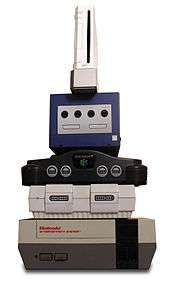Nintendo video game consoles
The Japanese multinational consumer electronics company Nintendo has developed seven home video game consoles and multiple portable consoles for use with external media, as well as dedicated consoles and other hardware for their consoles. As of September 30, 2015, Nintendo has sold over 722.22 million hardware units.[1][2]
Although the company had earlier released Color TV Game and Game & Watch consoles, which were their first and second consoles respectfully, they did not achieve worldwide success until the release of the Nintendo Entertainment System (NES) in 1983. The NES restarted the video game industry after the video game crash of 1983, and was an international success. In 1989, Nintendo released the Game Boy, which became the first handheld console to sell in large numbers. In the early 1990s, Nintendo's market lead began to decrease; although the 1990 Super Nintendo Entertainment System (SNES) was a strong seller, the Mega Drive/Genesis was a very strong contender. Nintendo and Sega would both lose a significant portion of the console market towards the end of the 1990s, as Sony Computer Entertainment's PlayStation became the most popular consoles, beating the Nintendo 64, though Nintendo managed to sell more than Sega Saturn.
The Dreamcast, released in 1999, PlayStation 2, released in 2000, and Microsoft's Xbox, released in 2001, would eventually relegate Nintendo into third place in the international market, despite the release of the GameCube. However, they retained their lead in the handheld console market, with the Game Boy Color and Advance models. Towards the middle of the 2000s, Nintendo introduced the first successful handheld device with a touch screen (DS) and the first successful console designed for motion controlled inputs (the Wii); they became some of the best-selling consoles of all time. In 2010, Nintendo became the first major company to release a handheld game console with stereoscopic 3D capabilities, with the 3DS, which had very strong sales from the beginning. The Wii U, released in 2012, was much less successful, and sales were significantly lower than predicted. The company's next system, Nintendo Switch, is slated for a 2017 release.
Home consoles
Nintendo Entertainment System

Released October 18, 1985, The Nintendo Entertainment System (NES) is an 8-bit video game console released by Nintendo in North America, South America, Europe, Asia, Oceania and Africa and was Nintendo's first home video game console released outside Japan. In Japan, it is known as the "Family Computer" (or "Famicom", as it is commonly abbreviated). Selling 61.91 million units worldwide,[1] the NES helped revitalize the video game industry following the video game crash of 1983 and set the standard for subsequent consoles in everything from game design to business practices. The NES was the first console for which the manufacturer openly courted third-party developers. Many of Nintendo's most iconic franchises, such as The Legend of Zelda and Metroid were started on the NES.
Nintendo continued to repair Famicom consoles in Japan until October 31, 2007, attributing the decision to discontinue support to an increasing shortage of the necessary parts.[3][4][5]
Super Nintendo Entertainment System
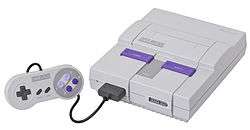
Released November 21, 1990, The Super Nintendo Entertainment System, officially abbreviated the Super NES or SNES and colloquially shortened to Super Nintendo, is a 16-bit video game console released by Nintendo in North America, South America, Europe, Asia, Oceania and Africa. In Japan it is known as the "Super Famicom". In South Korea, it is known as the Super Comboy and was distributed by Hyundai Electronics.
The Super NES was Nintendo's second home console, following the Nintendo Entertainment System. Whereas the earlier console had struggled in the PAL region and large parts of Asia, the Super NES was a global success, albeit one that could not match its predecessor's popularity in Northeast Asia and North America—due in part to increased competition from Sega's Mega Drive console (released in North America as the Genesis). Despite its relatively late start, the Super NES became the best selling console of the 16-bit era, selling 49.10 million systems worldwide.[1] The Super NES library is known for upgrading some of Nintendo's most famous franchises, and making the games even more critically acclaimed, such as Super Metroid, The Legend of Zelda: A Link to the Past, Final Fantasy IV and VI, Donkey Kong Country and Super Mario World, as well starting some popular franchises such as Star Fox, EarthBound and Mega Man X.
Nintendo 64

Released June 23, 1996, The Nintendo 64, commonly called the N64, and codenamed Ultra 64, was Nintendo's third home video game console for the international market. It was released with three launch games in Japan (Super Mario 64, Pilotwings 64 and Saikyo Habu Shogi) and two in North America (Super Mario 64 and Pilotwings 64). PAL regions also had three launch titles (Super Mario 64, Shadows of the Empire and Pilotwings 64) with Turok: Dinosaur Hunter delayed until three days after launch. Other key games included Donkey Kong 64, Diddy Kong Racing, Banjo-Kazooie, two games in The Legend of Zelda series, GoldenEye 007, Mario Kart 64, Super Smash Bros. and Star Fox 64. The Nintendo 64 sold 32.93 million systems.[1]
Nintendo GameCube
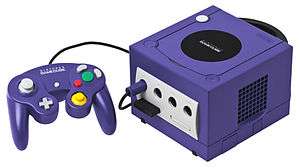
The Nintendo GameCube (commonly shortened to GameCube) is Nintendo's sixth generation game console, the same generation as Sega's Dreamcast, Sony's PlayStation 2 and Microsoft's Xbox. Until the console's unveiling at SpaceWorld 2000, the design project was known as Dolphin—this can still be seen in the console and its accessories' model numbers. The GameCube is the most compact sixth generation console. The GameCube is Nintendo's first game console to use optical discs rather than game cartridges. An agreement with the optical drive manufacturer Matsushita led to a DVD-playing GameCube system named the Panasonic Q, which was only released in Japan. Much of Nintendo's core line-up centered on sequels to their established hit franchises such as Super Mario Sunshine, Super Smash Bros. Melee, The Legend of Zelda: Wind Waker, Metroid Prime, Pokémon Colosseum and Star Fox Adventures, while new franchises like Animal Crossing and Pikmin were born, although the former franchise had seen a Japan-exclusive release on the N64. The GameCube has sold 21.74 million units.[1]
Wii
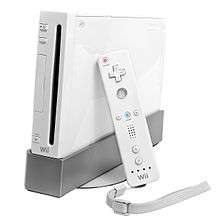
The Wii /ˈwiː/ is Nintendo's seventh-generation video game console. The system's code name was "Revolution", and as with the GameCube, this reference appears on the console and its accessories.
The major feature of the Wii console is the console's wireless controller, the Wii Remote, affectionately referred to as the Wiimote, that may be used as a handheld pointing device and can detect motion and rotation in three dimensions. The controller comes with a Nunchuk accessory which provides additional controls, including more motion sensing. The controller also contains a speaker and a rumble device to provide sensory feedback, and can be used to turn the console on and off. The console also features a stand-by mode entitled WiiConnect24, enabling it to receive messages and updates over the Internet while consuming little electrical power. The console is bundled with a game, Wii Sports. In Japan and Korea, Wii Sports is not included with the console, and is a standalone title. Nintendo later made a black version with both Wii Sports and Wii Sports Resort. This new version included the Wii MotionPlus accessory. As of December 31, 2013, the Wii has sold 100.90 million units worldwide.[1] The Wii, like the GameCube, is the smallest and most compact system in its generation. However, the Wii does not have the ability to match certain technical aspects of its competitors of its generation, such as high graphical complexity using hundreds of millions of polygons per second, Pixel Shader Model 3.0 and high-definition resolution (the Wii can only achieve 480p, as opposed to the Xbox 360 and PlayStation 3, which can achieve 1080p).
On December 15, 2006, Nintendo announced it would offer to replace wrist straps for 3.2 million Wii controllers. Consumers reported they were breaking during game play.[6]
By April 2007, the Wall Street Journal declared Nintendo had "become the company to beat in the games business" with the Wii outselling its home system rivals and overshadowing the better selling Nintendo DS portable.[7] Nintendo's profits were up 77% on the fiscal year due to Wii and Nintendo DS sales.[8]
Nintendo CEO Satoru Iwata has urged Nintendo not to get "complacent" due to the early success of the Wii. He continued by saying it was important "not to lose internal momentum and energy". Iwata urged Nintendo to continue its momentum.[9]
Wii U
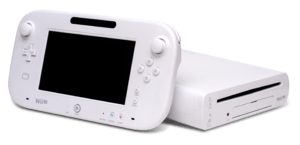
On April 25, 2011, Nintendo announced to investors their intention to release a successor to Wii in 2012.[10] The console was demonstrated in playable form at the Electronic Entertainment Expo 2011, and was suggested to be codenamed Project Café.[10][11] At E3 2011, the console's name, Wii U, was revealed. It plays not only Wii U games, but also Wii games, including Virtual Console, Wii Channels, and WiiWare. The Wii U is the first Nintendo console capable of full HD graphics at 1080P, and shipped with a new online system known as Nintendo Network, which features downloadable content, in-game purchases, community style multiplayer, and a user account system. The most prominent feature of the Wii U is the Wii U GamePad which features a touchscreen, motion controls, NFC, rumble, and a standard dual-analog based layout. It was confirmed that some games for the Wii U will also support its predecessor's Wii Remote, Wii Balance Board, and Classic Controller.
The Wii U was released in North America on November 18, 2012 priced at $299 for the basic model, and $349 for the premium model. The premium model came with a free game included (Nintendo Land), a sensor bar for playing Wii games, console stands and a game pad charging cradle, equipped with 32GB of storage. The basic model included the console, gamepad and 8GB of storage.
According to a report by an anonymous developer, the Wii U is apparently hard to program for due to a weak CPU, but a strong GPU, and bad software for developing games.[12] These claims have been denied by a different amount of developers recently, however.
The spring of 2014 has shown some signs of improvement in the Wii U's market share among the current generation of video game consoles. Mario Kart 8 was released on May 30, 2014 and sold over 1.2 million units in the first two days making it the fastest selling Wii U game ever.[13] Sales of the console quadrupled in the U.S. due to the popularity of the game and a bundle that includes the game and console.[14] "The early response to Mario Kart 8 demonstrates that the best days for Wii U are still ahead", said Nintendo of America president Reggie Fils-Aime.[13] After E3 2014, the game press industry had very positive things to say regarding the console. Examples can be seen in an Arstechnica article's subtitle "We play five exclusive Wii U games that set the stage for a better 2015" [15] and GameSpot's "Why Nintendo Won E3 2014".[16]
Games such as Super Mario 3D World, Mario Kart 8, Super Smash Bros. for Wii U, Splatoon, and Super Mario Maker pushed the Wii U's sales much higher, making the console more widely accepted from gamers.
Nintendo Switch
The Nintendo Switch is a hybrid device that can be used as either a home console inserted into a docking station that is attached to a television, or as a tablet-like portable console. It features two detachable wireless controllers, which can be used individually or attached to a grip to provide a traditional game pad form. The console's reveal trailer[17] showcased footage from The Legend of Zelda: Breath of the Wild and from potential new titles in the Super Mario, Mario Kart, and Splatoon franchises.
Portable consoles
Game & Watch

The Game & Watch series were handheld electronic games made by Nintendo and created by its game designer Gunpei Yokoi from 1980 to 1991. Most featured a single game that could be played on an LCD screen, in addition to a clock and an alarm. Most titles had a "GAME A" and a "GAME B" button. Game B is usually a faster, more difficult version of Game A. Different models were manufactured, with some consoles having two screens (the Multiscreen Series) and a clam-shell design. The Nintendo DS later reused this design. The Game & Watch made handhelds vastly popular. Many toy companies followed in the footsteps of Game & Watch, such as Tiger Electronics and their Star Wars themed games. Nintendo's Game & Watch units were eventually superseded by the original Game Boy. Each Game & Watch was only able to play one game, due to the use of a segmented LCD display being pre-printed with an overlay. The speed and responsiveness of the games was also limited by the time it took the LCD to change state. The Game & Watch sold over 80 million units worldwide.
Game Boy

The Game Boy line is a line of handheld game consoles sold by Nintendo. It is one of the world's best-selling game system lines, with over 200 million units sold worldwide.[1] The classic Game Boy was sold in a number of different revisions and variations, including the streamlined Game Boy Pocket and the Game Boy Light in Japan. In 1998, Nintendo released the Game Boy Color, a new Game Boy platform with color graphics. Combined,[18] the Game Boy and Game Boy Color sold 118.69 million units worldwide.[1]
Virtual Boy

Nintendo's Virtual Boy (also known as the VR-32 during development) was the first portable game console capable of displaying true 3D graphics. Most video games are forced to use monocular cues to achieve the illusion of three dimensions on a two-dimensional screen, but the Virtual Boy was able to create a more accurate illusion of depth through an effect known as parallax. The Nintendo 3DS also uses this technology. In a manner similar to using a head-mounted display, the user looks into an eyepiece made of neoprene on the front of the machine, and then an eyeglass-style projector allows viewing of the monochromatic (in this case, red) image. It was released on July 21, 1995 in Japan and August 14, 1995 in North America and at a price of around US$180. It met with a lukewarm reception that was unaffected by continued price drops. Fewer than fifteen titles were made for Virtual Boy in North America, few of which were met with positive reception. The system is rarely mentioned by Nintendo, however it is seen through microgames in WarioWare games. Nintendo discontinued the Virtual Boy within a few months of release.
Game Boy Color

In 1998, Nintendo introduced the Game Boy Color as the successor to the original Game Boy.[19] It features a color screen and an 8-bit processor and a custom Zilog Z80 central processing unit.[20] It was made to compete with the WonderSwan Color and the Neo Geo Pocket. Its best selling game was Pokémon Gold and Silver series.[21][22]
Game Boy Advance

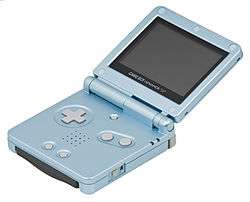
In 2001, Nintendo introduced the Game Boy Advance, the first major technological upgrade to the Game Boy line. Nintendo later released two revised models of the Game Boy Advance. The Game Boy Advance SP features a smaller clamshell design, and introduced a built-in screen light and rechargeable battery as standard features for Nintendo handhelds. The Game Boy Micro is an even smaller variant with interchangeable designer faceplates. The three Game Boy Advance models have sold 81.51 million units worldwide.[1]
Nintendo DS
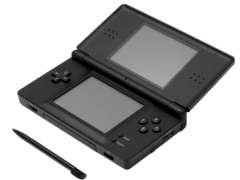
The Nintendo DS (abbreviated NDS or DS, and iQue DS in China) is a handheld game console developed and manufactured by Nintendo, released in 2004. It is visibly distinguishable by its horizontal clamshell design, and the presence of two displays, the lower of which acts as a touchscreen. The system also has a built-in microphone and supports wireless IEEE 802.11 (Wi-Fi) standards, allowing players to interact with each other within short range (10–30 meters, depending on conditions) or over the Nintendo Wi-Fi Connection service via a standard Wi-Fi access point. According to Nintendo, the letters "DS" in the name stand for "Developers' System" and "Double Screen", the former of which refers to the features of the handheld designed to encourage innovative gameplay ideas among developers.[23] The system was known as "Project Nitro" during development.
On March 2, 2006, Nintendo released the Nintendo DS Lite, a redesigned model of the Nintendo DS, in Japan. It was later released in North America, Australia and Europe.
As of December 31, 2013, Nintendo DS consoles have sold 153.98 million units, including 93.86 million Nintendo DS Lites.[1]
A second redesign of the Nintendo DS, the Nintendo DSi, was released on November 1, 2008, in Japan, on April 2, 2009 in Australia, April 3, 2009 in Europe, and April 5, 2009 in North America. It contains two cameras and downloadable software capabilities, plus a built-in flash memory and web browser. An SD card slot replaces the Game Boy Advance cartridge slot. A similar model, known as the Nintendo DSi XL, was released in 2010. It features the same configurations as its predecessor, but is slightly larger and features a large stylus designed for home use. As of December 31, 2013, Nintendo DSi consoles have sold 41.33 million units.[1]
Nintendo 3DS

Although the name and look of the device are similar to that of the DS series, Nintendo considers it to be the successor to the DS and a brand new console. It contains three cameras, two on the outside (for 3D photographs) and one internal one above the top screen. The bottom screen is a touch screen comparable to the DS bottom screens, and the top screen is Wide Screen and an autostereoscopic 3D LCD. Autostereoscopy is a process that sends different images to the left and right eyes to enable the viewer to view the screen in 3D "without the need for special glasses". The 3DS is said to enhance Nintendo's online experience. In 2012, the 3DS XL was released, similar to the change between the DSi and DSi XL. It has 90% larger screens and design changes such as a matte finish and the stylus in a more accessible area. The 2DS was released on October 12, 2013. Another redesign, the New Nintendo 3DS, was released in Japan in October 2014, Australia for November 2014, and everywhere else in February 2015. It includes a C-Stick, ZR and ZL shoulder buttons and a faster CPU, allowing for more software specifically for the New Nintendo 3DS (such as Xenoblade Chronicles 3D). Like the original 3DS, the New Nintendo 3DS also has an XL form. As of December 31, 2013, Nintendo has sold 42.74 million units, including 15.21 million Nintendo 3DS XLs and 2.11 million Nintendo 2DS units.[1]
Nintendo Switch
The Nintendo Switch is both a home console and a portable console. More information can be found in the home consoles section of this article.
Other hardware
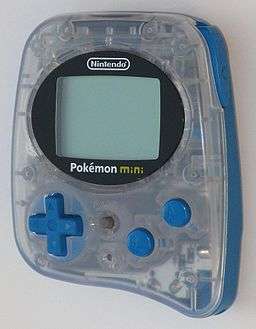
- Game Boy Camera – a monochrome camera cartridge for the original version of the Game Boy which includes a picture editor and the ability to print pictures via Game Boy Printer
- Satellaview – only released in Japan, an add-on for the Super Famicom (Japanese SNES) which allowed anyone to download games by a satellite
- Game & Watch – a series of handheld games made by Nintendo from 1980 to 1991
- Game Boy Player – an adapter for playing Game Boy games on the GameCube
- Game Boy Printer – an adapter designed for printing things from the Game Boy onto adhesive stickers. For example, it was used for printing out Game Boy Camera pictures and Pokémon information from the Pokédex in the Game Boy Pokémon games.
- iQue Player – a version of the Nintendo 64, with double the clock speed and downloadable games, released only in China
- iQue DS – a version of the Nintendo DS released only in China
- Nintendo 64DD – only released in Japan, this add-on system's games are on rewritable magnetic disks. Games released include a paint and 3D construction package, F-Zero X Expansion Kit, for creating new F-Zero X tracks, a sequel to the SNES version of SimCity, SimCity 64 and others.
- Pokémon Mini – unveiled in London at Christmas 2000, the Pokémon Mini was Nintendo's cheapest console ever produced; with games costing £10 ($15) each, and the consoles costing £30 ($45). This remains the smallest cartridge-based games console ever made. Sales of this console were poor.
- Mobile System GB – released in Japan on December 14, 2000. The Mobile System is an adapter to play Game Boy Color games on mobile phones. Pokémon Crystal was the first game to take advantage of the Mobile System. The player can hook an adapter to their Game Boy and connect it to a mobile phone which people can receive news, trade, and battle with other players across Japan.
- Pokémon Pikachu – a handheld device similar to the popular Tamagotchi toy which allows the user to take care of Pikachu in the manner of a pet
- Super Game Boy – adapter for playing Game Boy games on the Super NES, displayed in color
- Triforce — an arcade system based on GameCube hardware, developed in partnership with Sega and Namco
- Yakuman – a handheld mahjong game released in 1983
- GameCube Microphone – used in Karaoke Revolution Party, Mario Party 6, Mario Party 7 and Odama for the GameCube. It recognizes basic sounds and incorporates them into gameplay.
- Nintendo Gateway – a proprietary hardware/software console available on commercial aircraft and hotel properties,[24] providing shopping, information, and interactive entertainment[25]
- Panasonic Q – a version of the GameCube which could play DVDs developed by Panasonic
- Pokéwalker – a Pedometer used in Pokémon HeartGold and SoulSilver that can be used to enhance your Pokémon HeartGold and SoulSilver game by giving you special Pokémon and items as well as other added benefits that reward you depending on how many steps you take.
- Activity Meter – an Infrared (IR) Pedometer for use the Nintendo DS game, Personal Trainer: Walking
- Fit Meter – a portable accessory for use with the Wii U game, Wii Fit U, that tracks the number of steps taken and the elevation climbed. Can be synced with the game using the Wii U GamePad.
References
- 1 2 3 4 5 6 7 8 9 10 11 12 "Consolidated Sales Transition by Region" (PDF). Nintendo. 2014-01-28. Retrieved 2014-01-29.
- ↑ "Iwata Asks: Game & Watch". Nintendo of America. Retrieved 2013-06-23.
- ↑ 初代「ファミコン」など公式修理サポート終了. ITmedia News (in Japanese). ITmedia. 2007-10-16. Retrieved 2008-01-20.
- ↑ RyanDG (2007-10-16). "Nintendo of Japan dropping Hardware support for the Famicomfyt78ji78t9imkghm bnmvhui56iokhbut6i87ioguyu8". Arcade Renaissance. Retrieved 2008-01-20.
- ↑ "Nintendo's classic Famicom faces end of road" (Reprint). AFP. 2007-10-31. Retrieved 2007-11-09.
- ↑ Hans Griemel (2006-12-15). "Nintendo to replace 3.2 million straps". ABC News. Retrieved 2007-06-14.
- ↑ Nick Wingfield and Yukari Iwatani Kane, Wii and DS Turn Also-Ran Nintendo Into Winner in Videogames Business, Wall Street Journal, April 19, 2007
- ↑ Nintendo Profits Up 77 Pct. on Wii Sales, Associated Press, April 26, 2007.Wii Mini was also released.
- ↑ Stuart Bishop. "Iwata: Success mustn't make us complacent". ComputerAndVideoGames.com.
- 1 2 "Re: Wii's successor system" (PDF). Nintendo. 25 April 2011. Retrieved 25 April 2011.
- ↑ "'Wii 2' Codenamed 'Project Café'". IGN. 2011-04-15. Retrieved 2011-04-16.
- ↑ "The Secret Developers: Wii U - the inside story". Eurogamer. 11 January 2014. Retrieved 20 January 2014.
- 1 2 "Mario Kart 8 Sells 1.2 Million, Becoming Wii U's Fastest-Selling Game". GameSpot.
- ↑ Justin Towell (14 October 2014). "How to be good at Driveclub - GamesRadar". GamesRadar+.
- ↑ "Nintendo at E3: A comeback is always just a game away". Ars Technica.
- ↑ "Why Nintendo Won E3 2014". GameSpot.
- ↑ https://www.youtube.com/watch?v=f5uik5fgIaI
- ↑ "A Brief History of Game Console Warfare: Game Boy". BusinessWeek. Retrieved 2008-01-25.
- ↑ Umezu; Sugino. "Nintendo 3DS (Volume 3 – Nintendo 3DS Hardware Concept)". Iwata Asks (Interview: Transcript). Interview with Satoru Iwata. Nintendo. Retrieved 2011-03-07.
- ↑ "GBC Hardware Info". The Internet. Retrieved 2007-09-27.
- ↑ "Japan Platinum Game Chart". The Magic Box. Retrieved 2007-09-27.
- ↑ "US Platinum Videogame Chart". The Magic Box. Retrieved 2007-09-27.
- ↑ "Nintendo DS Frequently Asked Questions". Nintendo. Retrieved 2006-04-02.
- ↑ Other Stuff. DieHard GameFan. Volume 1. Issue 12. No.12. P.163. November 1993.
- ↑ "Gateway System Gets Shanghaied". GamePro (56). IDG. March 1994. p. 186.
